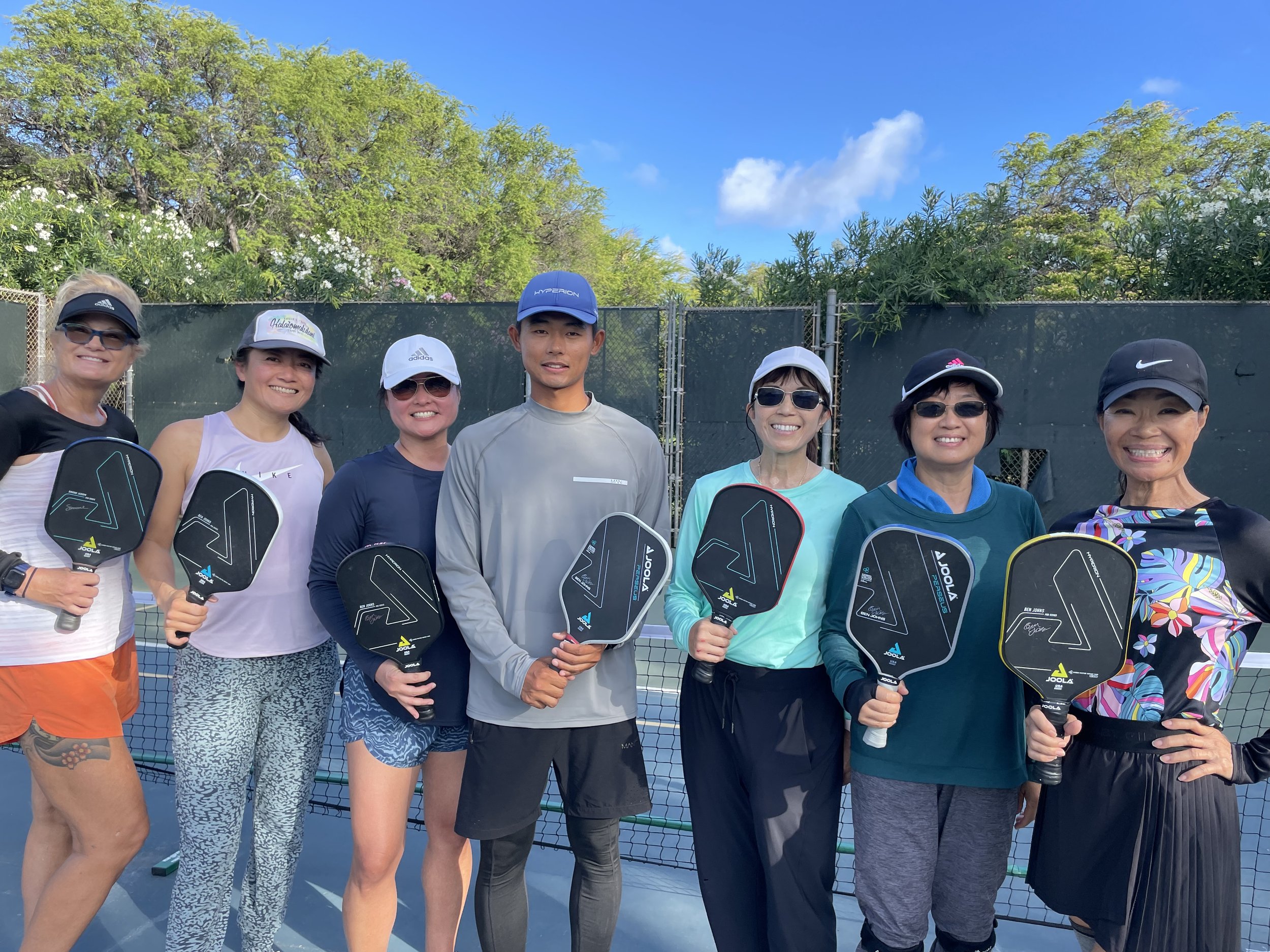GET STARTED
Pickleball friends I’ve made while taking lessons! From L-R: Kelsey, Hanna, me, Coach Yoshi, Lynne, Yan, and Mo
“How do I get started playing pickleball?”
It’s the question I get asked the most from people who have heard about pickleball and are curious about it.
To answer that question, here’s the unofficial guide to getting started playing pickleball in Hawai’i:
Register for a public group lesson for newbies/beginners. Check the local organizations in your area to see if there are any public group lessons being offered.
On O’ahu, the City and County of Honolulu provides free (yep, free!) group lessons. Another alternative—I got my start taking lessons offered by the Oahu Pickleball Association. The classes cap out at 8 students max, so they tend to fill up quickly.
For Hilo: I found a brochure on the Parks & Rec site for the Hilo Armory that offers pickleball classes for beginner, intermediate and advanced levels. The fee ranged from free to $1.00 (not a typo).
On Mau’i, Ralph Gorgoglione of the Maui Tennis & Pickleball Association provides group lessons at the Maui Vista condos. Visit mauivistadropin.com to check on dates, fees, and to register.
Small group lessons are a great gateway into the sport and you meet lots of cool people at the same time. Many classes will fill up quickly, so get on your local organizations’s mailing list, or regularly check their website for open registration.
Enroll in semi-private or private lessons. If the public group lessons are full, the next best way to get started is with semi-private or private lessons. Obviously, this is more spendy, but my pickleball friends who take semi-private lessons (and there are many of them that do!) swear by how valuable it is to improve their game. You’ll get more individualized attention and reps, and that’s never a bad thing. Every instructor sets their own rates/class structure, so ask around, or call your local organization to inquire.
Check out an “Open Play”. If lessons aren’t your thing, you could show up at a “Open Play” site. On O’ahu, you can find “hosted” open play courts through the Oahu Pickleball Association on Meetup.
When a pickleball site is “hosted”, the nets and balls are provided by a pickleball ambassador and basically, they’re providing the equipment and inviting anyone to play (bring your own paddle, though).
Even if you’re brand new to the game, most players/groups would appreciate you at least knowing the basics of the game; how to score/hit/where to stand, etc. If you don’t know where to start, YouTube is an absolute goldmine. **Note—this is not to say that you can’t attend an open play if you don’t. Most people are exceedingly kind and are more than willing to help you…it’s just that more often than not, you may end up feeling bad…so go and watch some YouTube videos, get some lessons under your belt or play with a friend group first, before foraying out into an “open play” with zero pickleball knowledge or experience.
If you stop by a court that has a pickleball net set up, but it’s not a “hosted” event, this means that the nets have been set up by someone who has invited a specific group of people to play.
If you’re on Kaua’i, Mau’i, or the Big Island, check out our “where to play” page for links to courts and more information.
Get a paddle, balls and court shoes. Once you’ve decided to either take lessons or go to an open play, it’s time to think about gear. To get started, you need only three things: a paddle, a pickleball, and court shoes.
My recommendation would be to get a decent starter paddle and try other pickleball friends’ paddles to figure out what you like. If you take lessons, your instructor may have demo paddles that you can try out. I bought the Selkirk bundle, which includes two paddles, two balls, and a drawstring backpack/carry bag. The paddles are pretty highly rated on Amazon and were perfectly fine to play with when just starting out. You could go all out with a $200 paddle from the get-go, but it’s hard to know what you like until you play for a bit.
If you take lessons and attend a “hosted” open play, balls will be provided, but it’s still a good idea to have a few on hand. When I busted out the balls from my Selkirk bundle at a Hosted Open Play (outdoor courts), I was told they were indoor balls LOL. So that you don’t run into the same issue, here are the differences between indoor and outdoor pickleballs:
An indoor ball has fewer and larger holes than outdoor balls. They weigh less, are softer, and provide better performance indoors where wind is not a factor and the court is smooth.
An outdoor ball has more holes that are smaller than those found on an indoor ball. The ball is heavier, harder and made of more durable plastic. The design provides better performance in wind and more durability for rough outdoor courts.
As for shoes, when I started, I was using really lightweight, cross-trainer type shoes. Within a few months, the bottoms were falling off. I bought court shoes and I realized how much support and stability a court shoe provides vs. a non-court shoe. Invest in court shoes!
Go out and play! Show aloha to others and you’ll find yourself being invited to play with awesome people that you would never have crossed paths with—if it weren’t for your mutual love for (and obsession with!) pickleball.
*Disclosure: Some of the links above are affiliate links. This means that, at zero cost to you, I will earn an affiliate commission if you click through the link and finalize a purchase.


